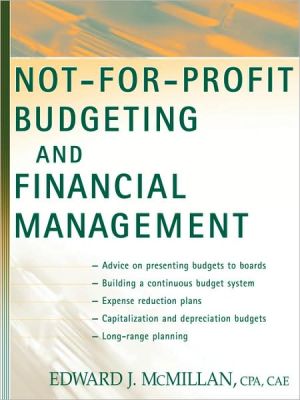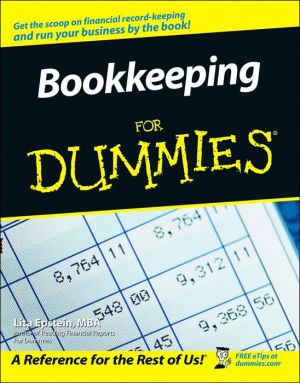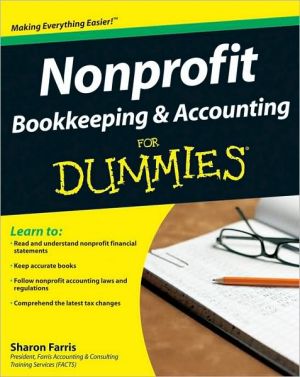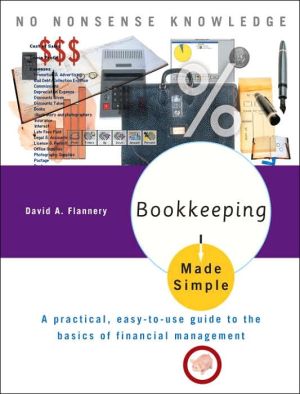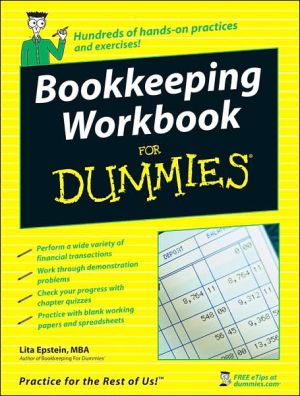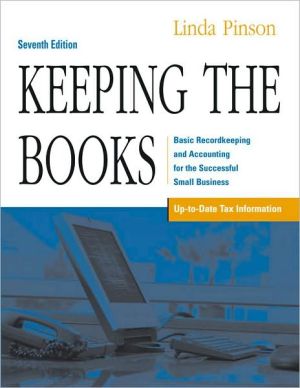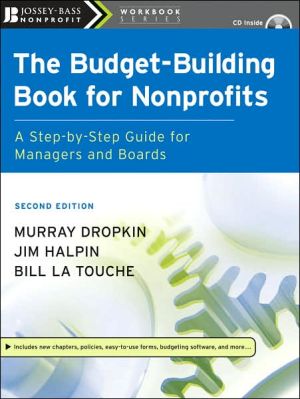Not-For-Profit Budgeting
Here's a system of budgeting that is easy to implement, easy to monitor, will significantly reduce staff time spent on budgeting, and will ensure true fiscal accountability. Written in a nontechnical, understandable, how-to language and format, this handy guide includes dozens of relevant forms and documents.\ Order your copy today!
Search in google:
Take control of your organization’s short- and long-term financial planThe trend toward decentralizing decision-making powers in not-for-profit organizations means a greater number of employees are responsible for creating and managing the annual budget. Budgets, therefore, must be well designed, easy to implement, and accessible to professionals from a variety of backgrounds. Wishful thinking? Not any more. Continuous budgeting, as explained in Edward McMillan’s trenchant Not-for-Profit Budgeting and Financial Management, offers a system that is not only easy to use and monitor, but also ensures true fiscal accountability in the complex not-for-profit arena.Continuous budgeting breaks down time-consuming annual budgeting processes into twelve easy-to-manage increments that produce more accurate and effective resource allocation. In this handy guide, the author explains how to:Separate controllable, semi-controllable, and fixed expensesTake corrective actions during the year to offset budget shortfallsDefine the roles of the CEO, CFO, the staff, and volunteer leadersEstablish expense reduction plans before they are neededPrepare and present such top-notch budget documents that budgets will be approved the first timeMcMillan writes in a nontechnical, understandable, how-to language and format, incorporating dozens of relevant forms and documents. This completely revised and expanded edition also includes all-new material on long-term financial planning, so that not-for-profits can work toward liberating themselves from the year-to-year scramble for increasingly scarce resources.Not-for-profit managers must be able to direct and control their resource allocation rather than be controlled by outdated, cumbersome, and inaccurate budgeting processes. Not-for-Profit Budgeting and Financial Management, and its powerful system of continuous budgeting, enables all not-for-profit professionals to create and manage reasonable financial plans that fit their organization’s needs.
\ Not-for-Profit Budgeting and Financial Management\ \ \ \ By Edward J. McMillan\ \ \ John Wiley & Sons\ \ \ \ Copyright © 2003\ \ Edward J. McMillan\ All right reserved.\ \ \ ISBN: 0-471-45314-5\ \ \ \ \ Chapter One\ \ \ Basic Accounting and\ Financial Operations\ \ A WELL-RUN ORGANIZATION must have an efficient financial operation in place to\ implement an effective budgeting program. An effective financial operation should\ integrate the following:\ * Accurate financial data\ * Understandable financial statements that meet the organization's needs\ * Timely financial statements\ * Actual versus budget figures for the period presented\ * An annual audit by an independent certified public accountant (CPA) firm\ \ Accurate Financial Data\ Financial statements are prepared by one of two accounting methods:\ * Cash basis of accounting-recognizes revenues when cash is received and expenses\ when cash is disbursed.\ * Accrual basis of accounting-recognizes revenues when they are earned and\ expenses when they are incurred. The actual receipt and disbursement of cash\ generally does not result in recognizing revenues and expenses. Accrual accounting\ also attempts to match revenues with corresponding expenses in the proper\ accounting period.\ Unless an organization is very small or is a true cash business, the accrual\ method of accounting results in muchmore accurate and meaningful financial statements\ than the cash basis does. Accrual-based financial statements are more difficult\ to prepare, but the resulting accuracy is crucial to good budgeting.\ \ Understandable Financial Statements\ Financial statements should be constructed to provide management with what it\ needs to effectively control the organization. The statements should compare actual\ versus budget data for both the current month and the year to date. They should be\ understandable to nonaccounting management and easy to interpret. In addition,\ the statements should be streamlined, relatively brief, and not bogged down with\ unnecessary detail that will frustrate the reader.\ \ Timely Financial Statements\ Internal financial statements should be prepared and distributed monthly and\ within 10 business days after the close of the prior month. When the statements are\ prepared other than monthly and it takes longer than 10 days to prepare and distribute\ them, management's ability to take well-thought-out action to correct problems\ diminishes. Rather, decisions are likely to be based on old data, problems may\ worsen, and valuable time that could have been used to correct the problem will\ have been lost.\ Internal financial statements should include, at a minimum, the two primary\ financial statements:\ * The Statement of Financial Position (the balance sheet)\ * The Statement of Activity (the income statement)\ \ Statement of Financial Position\ The Statement of Financial Position shows the overall financial health of an organization\ at a point in time by comparing the organization's assets, liabilities, and net\ assets. It usually does not reflect actual versus budget goals. The Statement of Financial\ Position illustrates an organization's solvency and cash position but does not\ reflect profitability. A sample Statement of Financial Position for a typical not-for-profit\ organization is shown in Exhibit 1.1.\ \ Statement of Activity\ The Statement of Activity shows the profitability of an organization for a specific\ period by comparing revenues and expenses. It does not reflect the organization's\ solvency. The Statement of Activity illustrates both current-month and year-to-date\ figures to help management understand the financial condition of the organization.\ It also serves as a budgeting tool. A sample Statement of Activity for a typical not-for-profit\ organization is shown in Exhibit 1.2.\ \ Annual Audit\ An effective budget is based on accurate financial data. Management can ensure\ records are accurate by having the records audited by an independent CPA firm. The\ audit process requires the CPA firm to advise and make recommendations to management\ as to weaknesses and problems with accounting systems. Management may\ not be aware of these problems, and the audit will afford an opportunity to correct\ deficiencies. In addition, an audit will include an internal control survey and a management\ letter:\ * An internal control survey is designed to expose weaknesses surrounding the\ safeguarding of cash and other assets and is an annual requirement of a CPA's\ auditing standards.\ * A management letter is the vehicle CPA firms use to alert management to inefficiencies\ that come to light during the audit. The management letter also includes\ recommendations for improvement.\ \ Organizations that cannot afford a full audit should at least consider a less costly\ review or compilation.\ (Continues...)\ \ \ \ \ \ \ \ \ Excerpted from Not-for-Profit Budgeting and Financial Management\ by Edward J. McMillan\ Copyright © 2003 by Edward J. McMillan.\ Excerpted by permission.\ All rights reserved. No part of this excerpt may be reproduced or reprinted without permission in writing from the publisher.\ Excerpts are provided by Dial-A-Book Inc. solely for the personal use of visitors to this web site.\ \ \
List of ExhibitsPrefaceCh. 1Basic Accounting and Financial Operations1Ch. 2Effective Use of Footnotes and Financial Ratio Calculations for the Statement of Financial Position7Ch. 3Controllable and Uncontrollable Expenses13Ch. 4Controllable, Semi-Controllable, and Fixed Expenses17Ch. 5Noncash Expenses21Ch. 6Natural and Functional Statements of Activity25Ch. 7Internal Financial Statements29Ch. 8Budgeting Philosophy37Ch. 9Continuous Budgeting System Overview39Ch. 10The Executive and the Budget Process43Ch. 11Expense Reduction Plans47Ch. 12The Monthly Budget Process51Ch. 13The Cash Flow Budget65Ch. 14Getting the Budget Approved69Ch. 15Suggested Format of Budget Documents for an Approving Body71Ch. 16The Role of the Budget Coordinator87Ch. 17Accounting and Budgeting for Fringe Benefits91Ch. 18The Capital Budget and Depreciation93Ch. 19Inventory Purchases and Calculation of Cost of Goods Sold97Ch. 20Accounting and Budgeting for Dues99Ch. 21Capital Assets: Lease-or-Buy Decisions105Ch. 22The Long-Range Plan107Ch. 23Financial Ratios109Ch. 24Zero-Based Budgeting113Ch. 25Putting It All Together115Glossary133Index139
